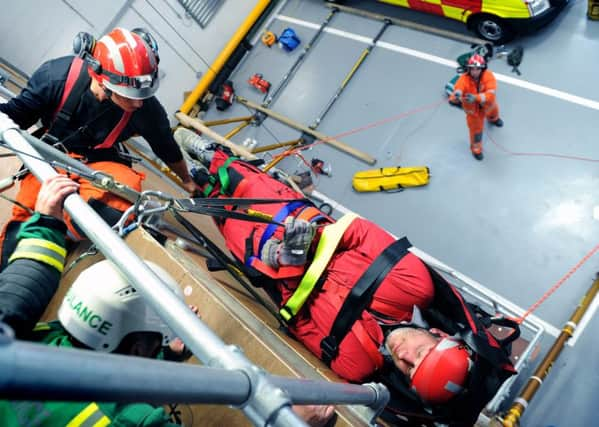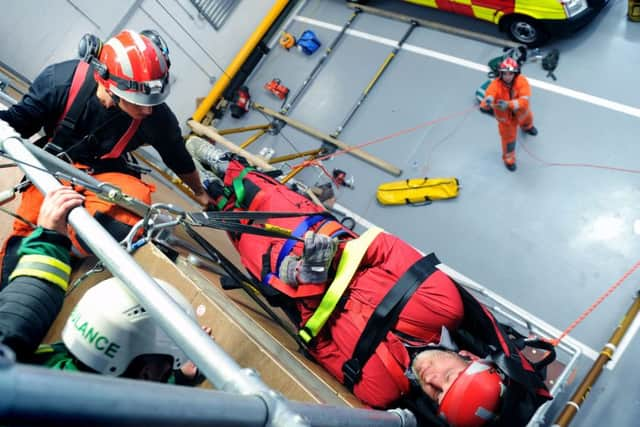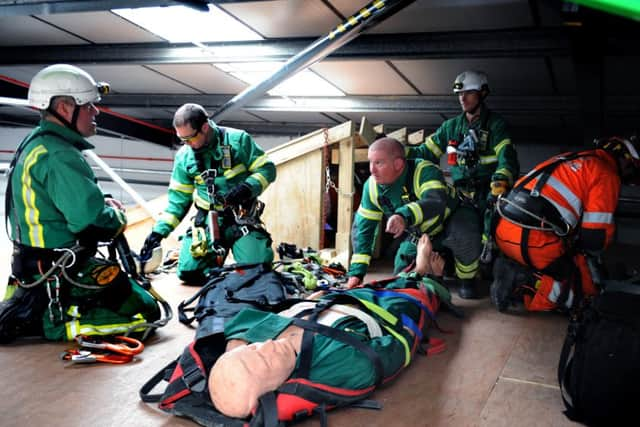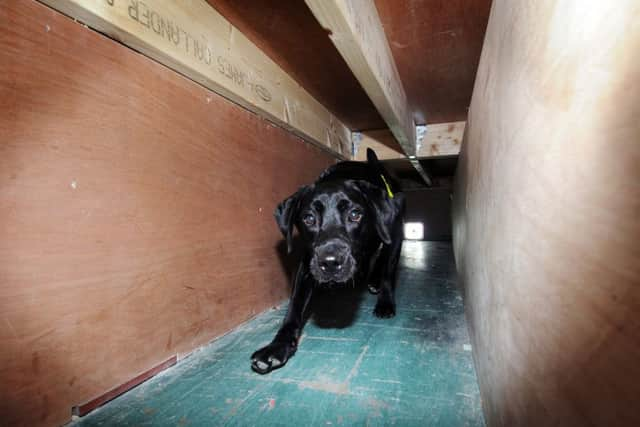Disaster training for real - what it feels like to be trapped in a collapsed building...


All of a sudden the seemingly innocuous sunglasses bit sharply into the back of my knee and because of the confined space, there was very little I could do about it.
So there I was, lying motionless in a pitch black tunnel less than two feet square with Darren the paramedic checking my breathing and circulation and telling me out loud the various other things he was doing to me.
Advertisement
Hide AdAdvertisement
Hide AdOnce my leg was “tractioned”, Darren announced he’d given me “1gm of IV paracetamol” and, because I had no pulse in my left leg, “250 bolus of fluid”, followed by “5ml of titrated morphine”, adding he was saving the ketamine for extraction. It was like listening to an episode of ER. Except there was no carefully coiffured doctors in a spacious, well equipped operating theatre, just three sweaty blokes in a tunnel the width of your average coffin.


Darren, of course, wasn’t giving all this information for my benefit. Rather, he was talking to Graham Butterworth, an instructor with West Yorkshire Ambulance Service, who was lying just out of sight below my feet, a little further down the tunnel.
For all intents and purposes I was a real patient stuck in what the emergency services refer to as ‘the pancake’, essentially a partially collapsed building which has resulted in the creation of numerous voids and hazardous spaces.
It was a joint emergency service training search and rescue exercise involving West Yorkshire Fire and Rescue Service and Yorkshire Ambulance Service (YAS) and I’d volunteered to be a patient.
Advertisement
Hide AdAdvertisement
Hide AdThe fire service had USAR - the Urban Search and Rescue team, while the ambulance crews had HART, the Hazardous Area Response Team.


We were at the YAS training centre in Beeston, a warehouse inside part of which was a mock-up wooden house, next to which was a metal structure meant to simulate a collapsed crane.
What I did not expect, however, is how real the whole thing actually felt.
Rewind a couple of hours and myself and Graham, HART training and support manager at YAS, who explained: “These types of exercise are very important as they allow for essential joint working between services, so we are ready for real-life emergencies.
Advertisement
Hide AdAdvertisement
Hide Ad“The role of paramedics has changed massively in recent years, so we now have specialists entering buildings alongside firefighters and able to begin working on patients at the scene - in some cases they can even carry out surgical procedures.”


The 39-year-old was my guide as we made our way into the house toward the ‘the pancake’. It meant crawling on hands and knees and eventually just sliding forward on your stomach.
I was told to bang on the wall and yell for help and I could hear others doing this in other parts of the building, some with more gusto than others. Indeed, the acting talents of the assembled emergency service personnel was something of a revelation.
Even as we arrived at the training centre at 9am and with some crew members still donning their overalls, a man suspended from a harness on a makeshift crane some 20ft off the ground began shouting.
“Help! Help! Get me out!”
Advertisement
Hide AdAdvertisement
Hide AdAfter a few minutes and with no help in sight, he let his harness slip so that he was now clear of the crane structure, suspended in mid air.
“After a few minutes, he’ll begin getting more agitated,” said Andy Rose, national resilience watch manager with the fire service. “He may even swear, because that’s what we’d get in a real situation. If they don’t get a move on and rescue him soon, he’ll begin fitting.”
A dog handler called Darren Booth turns up with Spencer, a six-year-old springer spaniel. Darren is taking part in the exercise but he was also involved the Cheshire wood mill fire in July in which four people died, a scene he described as “complete devastation”.
He showed me just how powerful Spencer’s nose was after the dog successfully located one of the pretend casualties, first through the wooden wall and later by entering the building.
Advertisement
Hide AdAdvertisement
Hide AdAbout an hour after crawling into the pancake I began to get the sense that emergency crews were getting closer and my cries for help, accompanied by forceful banging on the wall, were at last answered. Someone up on the roof asked my name and if I was okay and what kind of injuries I had.
Graham informed me I had a broken leg, hip pain and shallow breathing and I relayed the information up. It was still another half hour before anyone managed to locate us though but my hopes for a swift exit were soon dashed after I was informed I would need to be stretchered out, which wasn’t easy given the lack of space.
Graham explained: “We make it difficult because in real life, you don’t know what to expect.”
The makeshift building has multiple points of entry but for the purposes of the exercise, crews were told the only access was a small cellar window, which they found fitted with steel bars and an iron plate. It’s not the first time they’ve had to make entry through a small gap - on a previous exercise, they had to enter through a tumble dryer.
Advertisement
Hide AdAdvertisement
Hide AdBack in the tunnel, I was inched awkwardly onto a stretcher. It took two of them to pull and push the stretcher up the passage and somehow - I still have no idea exactly how - they managed to get me around a 45 degree bend, before I was manhandled up onto the roof, only to have another agonising wait while the various service personnel discussed how best to get me to the ground.
“Feet first or horizontal?” I heard one ask. Inside, I prayed for horizontal. At one point, a kindly face appeared, winked and said: “Don’t worry, these cables are designed to hold the weight of a Land Rover. Relax, just go to sleep.”
Sadly, sleeping or relaxing weren’t options.
And then suddenly Graham was there again, asking me if I was still okay to go over the top. “Yeah, fine,” I lied.
“Because you can just say ‘get me out of here for real’ and we’ll stop.” I was sorely tempted. So there I sat and watched, squirming, sweating, as I was heaved over the side and lowered ever so slowly toward the unforgiving concrete floor.
Advertisement
Hide AdAdvertisement
Hide AdAt the bottom, feeling the rush of achievement, I turn to ask Graham how high the building is… 40ft Maybe 50?
“Twenty,” he says flatly. Hmm. It felt higher. On the plus side, though, my brain had suddenly decided the pain in my leg really wasn’t that bad after all.
FACTFILE
The Urban Search And Rescue (USAR) was established in 2006/7 - there are 20 USAR teams in England and in Wales.
Since 2006 West Yorkshire’s USAR team has been called on around numerous times.
Advertisement
Hide AdAdvertisement
Hide AdThey have a rescue dog called Eddie, a black Labrador, and also host a rescue dog for Tyne and Wear, Spencer, a springer spaniel.
When attending an incident the rescue dogs wear jackets and rubber shoes to protect their feet from the rubble.
USAR have just been called back to the Cheshire wood mill fire, which they initially attended for nine days
Yorkshire Ambulance Service have the HART (Hazardous Area Response Team), with operatives able to work alongside firefighters.